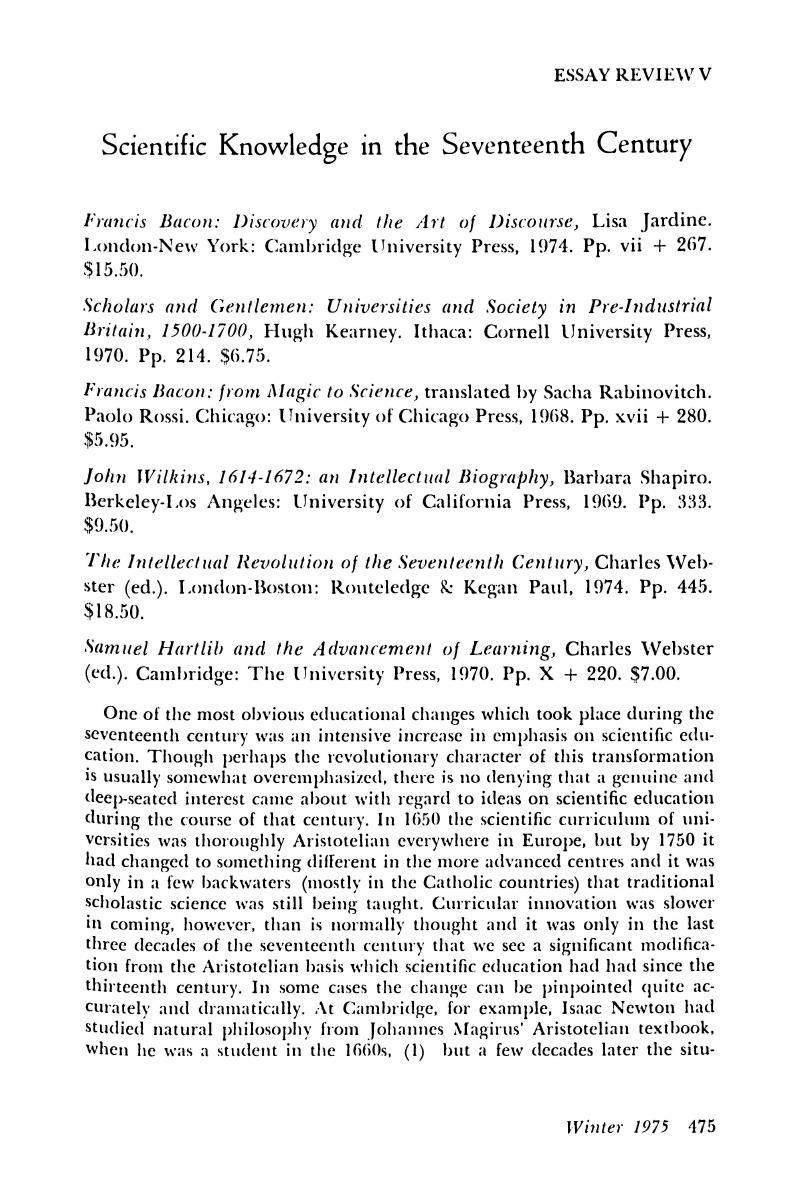Published online by Cambridge University Press: 02 June 2017

1. Hall, A. R., “Sir Isaac Newton's Notebook, 1661–1665”, Cambridge Historical Journal, 9 (1948): 239–50.Google Scholar
2. [Waterland, Daniel], Advice to a Young student with a Method of Study for the First Four Years (London, 1730).Google Scholar
3. Ruestow, E. G., Physics at 17th and 18th Century Leiden (The Hague, 1973).Google Scholar
4. See the material collected in Risse, W., Die Logik der Neuzeit (Stuttgart-Bad Cannstatt, 1964f.).Google Scholar
5. Schmitt, C. B., “Towards a Reassessment of Renaissance Aristotelianism”, History of Science, 11(1973): 159–93 and “Philosophy and Science in Sixteenth-Century Universities: Some Preliminary Comments”, in Murdoch, J. E. & Sylla, E. D. (eds.), The Cultural Context of Medieval Learning (Dordrecht, 1975), pp. 585–537.Google Scholar
6. Especially I filosofi e le macchine (Milan, 1962), translated as Philosophy, Technology and the Arts in the Early Modern Era (New York, 1970).Google Scholar
7. It was given due emphasis, however, by Boas, George, “Recent Books in the History of Philosophy”, Journal of the History of Ideas, 19(1958): 571–92, esp. 584–7.Google Scholar
8. Lemmi, C., The Classical Deities in Bacon, a Study in Mythological Symbolism (Baltimore, 1933).Google Scholar
9. Farrington, B., Francis Bacon: Philosopher of Industrial Science (New York. 1949). Also see the same author's The Philosophy of Francis Bacon (Liverpool. 1964).Google Scholar
10. Another example of the same sort is Yates, Frances A., Giordano Bruno and the Hermetic Tradition (Chicago, 1964), which adds an important dimension to the interpretation of Bruno.Google Scholar
11. For one example see Walker, D. P., “Francis Bacon and Spiritus ”, in Science, Medicine and Society in the Renaissance: Essays to Honor Walter Pagel (New York, 1972), II, pp. 121–30.Google Scholar
12. For further details on this see Debus, A. G., Science and Education in the Seventeenth Century (London-New York, 1970).Google Scholar
13. Webster, Charles, “The Authorship and Significance of ‘Macaria’”, Past and Present no. 56 (1972), reprinted in The Intellectual Revolution…, pp. 369–85.Google Scholar
14. For details see the review by McConica, J. K. in English Historical Review 87 (1972): 121–5.Google Scholar
15. Jardine, Lisa, “The Place of Dialectic Teaching in Sixteenth-Century Cambridge”, Studies in the Renaissance, 21 (1974): 31–62.Google Scholar
16. See the work of Ruestow cited above in note 3 and the works of Sassen cited in Schmitt, “Towards a Reassessment…” (note 5), n. 18.Google Scholar